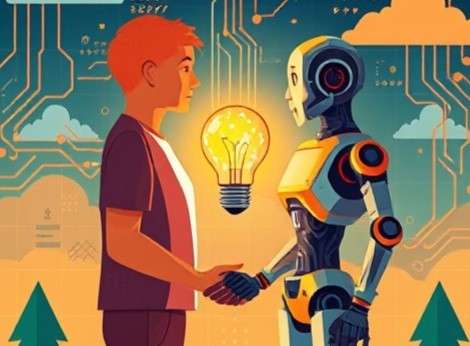
2024-10-23
Artificial intelligence
Understanding Artificial Intelligence: A Simple Guide for Everyone
By Techphant
Introduction
Artificial Intelligence, or AI, is a term that seems to be everywhere these days—from news headlines and tech conferences to movies and even household gadgets. But what exactly is AI, and why is it such a big deal? In this blog post, we'll break down the basics of AI in simple, everyday language to help you understand what it is, how it works, and why it matters.
What is Artificial Intelligence?
At its core, Artificial Intelligence refers to machines or computer programs that can perform tasks that typically require human intelligence. This includes things like understanding language, recognizing patterns, learning from experience, making decisions, and solving problems.
Imagine a smart assistant on your phone that can understand your voice commands, a recommendation system that suggests movies you might like, or a self-driving car that navigates traffic—all of these are examples of AI in action.
The Building Blocks of AI
AI isn't a single technology but a combination of several fields working together. Here are some key components:
1. Machine Learning
Machine Learning is a subset of AI where computers learn from data without being explicitly programmed. Instead of following strict instructions, these systems improve their performance by finding patterns in large amounts of data.
- Example: An email spam filter learns to identify unwanted emails by analyzing thousands of examples of spam and non-spam messages.
2. Deep Learning
Deep Learning is a type of machine learning that uses neural networks with many layers (hence "deep"). These networks can model complex patterns in data.
- Example: Facial recognition systems use deep learning to identify individuals by analyzing the subtle features of their faces.
3. Natural Language Processing (NLP)
NLP enables computers to understand, interpret, and generate human language.
- Example: Chatbots that can answer customer service questions or voice assistants like Siri and Alexa.
4. Computer Vision
This field allows computers to interpret and make decisions based on visual data from the world.
- Example: Self-driving cars use computer vision to detect pedestrians, other vehicles, and road signs.
How Does AI Learn?
AI systems learn from data much like humans learn from experience. Here's a simple breakdown:
- Data Collection: Gathering information relevant to the task.
- Data Processing: Cleaning and organizing data for analysis.
- Algorithm Application: Using mathematical models to find patterns.
- Model Training: Adjusting the model based on the data to improve accuracy.
- Testing and Validation: Checking the model's performance on new data.
For instance, to teach an AI to recognize cats in photos, you would feed it thousands of images labeled as "cat" or "not cat." Over time, the AI learns the features that distinguish a cat from other objects.
Where is AI Used Today?
AI is more integrated into our lives than you might think. Here are some common applications:
- Healthcare: Diagnosing diseases from medical images, predicting patient outcomes, personalizing treatment plans.
- Finance: Fraud detection, algorithmic trading, credit scoring.
- Retail: Inventory management, personalized shopping recommendations, customer service chatbots.
- Transportation: Route optimization, autonomous vehicles, traffic management systems.
- Entertainment: Content recommendations on platforms like Netflix and Spotify.
Benefits of AI
- Efficiency: Automates repetitive tasks, freeing up time for more complex work.
- Accuracy: Reduces human error in tasks like data entry or calculations.
- Personalization: Offers customized experiences based on individual preferences.
- Innovation: Opens up new possibilities in fields like medicine, environmental science, and engineering.
Challenges and Concerns
While AI brings many benefits, it also poses challenges:
- Job Displacement: Automation may replace certain jobs, requiring workforce adaptation.
- Privacy Issues: AI systems often require large amounts of personal data.
- Bias and Fairness: AI can perpetuate existing biases present in training data.
- Security Risks: Malicious use of AI, such as deepfakes or automated cyber attacks.
The Future of AI
The potential of AI is vast, and we're only at the beginning of exploring its capabilities. Future developments may include:
- Improved Human-AI Collaboration: Tools that enhance human decision-making.
- Advancements in Healthcare: Early disease detection and personalized medicine.
- Environmental Solutions: AI-driven climate modeling and resource management.
- Ethical AI Development: Greater emphasis on transparency, fairness, and accountability.
Conclusion
Artificial Intelligence is transforming the way we live, work, and interact with the world. By mimicking human intelligence, AI systems can perform complex tasks more efficiently and accurately than ever before. Understanding the basics of AI helps demystify the technology and prepares us for a future where AI plays an even more significant role.
Whether it's simplifying daily tasks, advancing scientific research, or creating new industries, AI holds the promise of tremendous benefits. As we embrace these changes, it's essential to consider the ethical implications and strive for solutions that benefit everyone.
